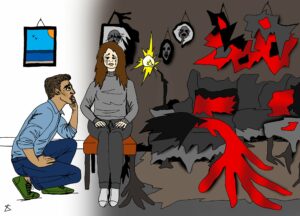Overview
A mood disorder is a type of mental illness that predominantly affects a person’s emotional state. It is a condition in which a person has periods of intense happiness, severe despair, or both.
Mood disorders include a wide range of mood problems, including major depressive disorder, dysthymic disorder, and bipolar disorder. These illnesses affect around 20.9 million American people.
If you have a mood disorder, your overall emotional state or mood is altered or inconsistent with your circumstances, which impairs your capacity to operate. You may feel terribly sad, empty, or irritable (depressed), or you may alternate between periods of despair and excessive happiness (mania).
Anxiety disorders may have a negative impact on your mood and are frequently associated with sadness. Suicide risk may be increased by mood disorders.
Mood disorders include the following:
- Major depressive disorder is characterized by protracted and persistent bouts of intense sorrow.
- Bipolar disorder, also known as manic depression or bipolar affective disorder, is a kind of depression characterized by alternating periods of despair and mania.
- Seasonal affective disorder (SAD) is a kind of depression that is most commonly connected with less daylight hours in the extreme northern and southern latitudes from late fall to early spring.
- Cyclothymic disorder is a disorder that produces less severe emotional ups and downs than bipolar disorder.
- Premenstrual dysphoric disorder is characterized by mood swings and irritability that occur during the premenstrual period of a woman’s cycle and subside with the commencement of menstruation.
- Dysthymia (persistent depressive disorder) is a long-term (chronic) type of depression.
- Disruptive mood dysregulation disorder (DMDD) is a chronic, severe, and persistent irritability problem in children, characterized by frequent temper outbursts that are out of proportion to the child’s chronological age.
- Depression associated with medical sickness – a persistently low mood and a major lack of enjoyment in most or all activities that is directly tied to the physical symptoms of another medical condition.
- Depression caused by substance use or medicine depression symptoms that appear during or shortly after substance use or withdrawal, or after being exposed to a medication
What causes mood disorders?
Depending on the type of disease, there might be numerous underlying causes. Mood disorders have been linked to a variety of genetic, biochemical, environmental, and other variables.
- Previous diagnosis of a mental illness in the family
- In the case of depression, trauma, stress, or big life changes
- Illness or the use of certain drugs Depression has been associated with
- Cancer, diabetes, Parkinson’s disease, and heart disease are examples of significant illnesses.
- In the case of bipolar disorder, brain anatomy and function
What are the symptoms of common mood disorders?
- Feeling sad most of the time or nearly every day
- Lack of energy or feeling sluggish
- Feeling worthless or hopeless
- Loss of appetite or overeating
- Gaining weight or losing weight
- Loss of interest in activities that formerly brought enjoyment
- Sleeping too much or not enough
- Frequent thoughts about death or suicide
- Difficulty concentrating or focusing
Bipolar illness symptoms can include both sadness and mania. Among the symptoms of hypomanic or manic episodes are:
- Feeling extremely energized or elated
- Rapid speech or movement
- Agitation, restlessness, or irritability
- Risk-taking behavior, such as spending too much money or driving recklessly
- Unusual increase in activity or trying to do too many things at once
- Racing thoughts
- Insomnia or trouble sleeping
- Feeling jumpy or on edge for no apparent reason
How are mood disorders treated?
Medications to treat depression and/or bipolar disorders
- Antidepressants
- Mood stabilizers
- Antipsychotics
Psychotherapy (talk therapy)
- Cognitive-behavioral therapy
- Interpersonal therapy
- Problem-solving therapy
Brain stimulation therapies
- Electroconvulsive therapy (ECT)
- Repetitive Transcranial Magnetic Stimulation (rTMS)
- Treatments for seasonal depression
- Light therapy


